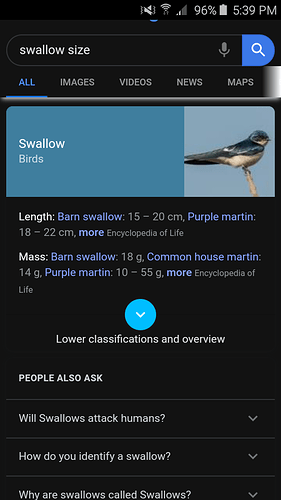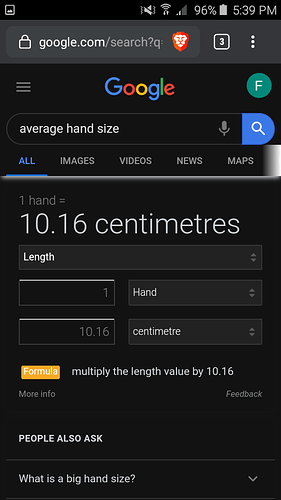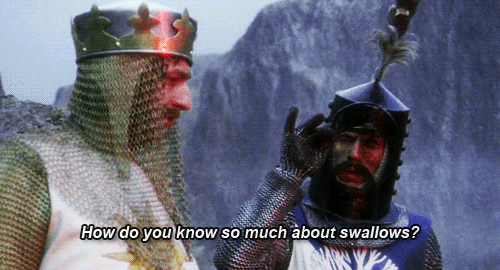Alright, nice.
To recap - there are three keys aspects:
-
Exploring sources of knowledge. (Google is our friend.)
-
Recognizing sets. (Semantics is the key.)
-
Applying logic to assertions. (Laaaaaagic.)
Let’s apply those principles to our lovely subject, and one of the examples provided:
Q: Is [swallow] bigger than an average man-sized hand?
Two crucially important sets can be recognized: Swallow, Bigger
Swallow is a family of birds comprising around 90 species. No single specie is called a swallow, neither by ornithologists, nor (universally) by layman.
No disambiguation is needed, the set is clear.
Bigger - relating to size, magnitude etc. How should we measure it and compare it? Using which criteria?
Extreme dimensions?
All dimensions?
Volume?
By trying to fit one into the other?
By trying to cover one by the other?
Some other way?
Without disambiguation, we need to account for all of those possible criteria - which comprise the set.
Brief fact checking tells us that various species of swallows range from ca 10 to 24 cm in length. Wing spans range from ca 20 to 40 cm. Volume unknown, silhouette surface areas unknown, we can only assume.
For a Q&A assertion to be true, it needs to be true for all the included sets (which include any possible combinations of their subsets).
Playing around with various combinations of subsets we arrive at various answer to the question.
Therefore, both of these assertions:
Q: Is it bigger than an average man-sized hand?
A: No.
Q: Is it bigger than an average man-sized hand?
A: Yes.
are false.
Thank you @Luxen and @PeteMcc, that about covers what I was looking for.
It also nicely expands on what I’ve already illustrated here: https://206.81.1.216/t/looking-for-a-thing/21104/54?u=seekersupreme - which wasn’t enough, apparently.
@FacuBlues, a fair attempt, yet better covered by the aforementioned two. Pro-tip: when advertising the size of your cock, don’t measure it the way you did with the hand;)
Based on the explanations provided, I’ve assigned three ranges:
|
|
| 1 - 1 |
FacuBlues |
| 2 - 4 |
Luxen |
| 5 - 7 |
PeteMcc |
Discobot will choose the next GM from those ranges: @discobot roll 1d7
There’s one more subject worth commenting on, as it was brought up by Luxen:
swallow’ (from swelgan) and swallow’’ (from swealwe) are two separate words. They’re homonyms, even better, they’re both homographs and homophones, but still, they are two different words with their separate entries in dictionaries.
The recognition of homonymity allows the GM to focus on a particular mystery word (a family of birds in this case), without concerning himself with its homonyms.
Now, both of those homonyms are also (independently) polysemes (with vastly different capacities), and polysemy might indeed introduce some issues. Still even here there are ways of avoiding ambiguity by applying linguistics. And then there’s also the choice of using one’s foresight and avoiding especially problematic polysemes altogether.
Regulating this aspect would be inherently very complex and arduous (as partially illustrated by Luxen’s attempt). Therefore we need to rely on our better judgment and try not to make life harder for ourselves.
![]()
![]()







